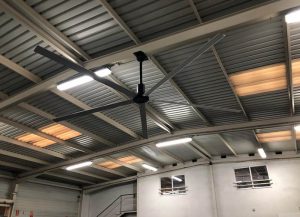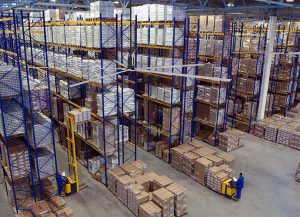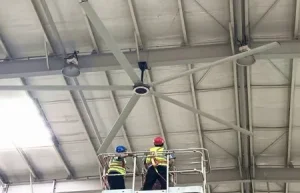Factories, warehouses, and gyms often struggle with intense heat and poor ventilation. This problem leads to lower productivity, rising energy bills, and frustration among staff. But there’s a straightforward solution: installing the right Industrieventilator delivers steady Luftstrom, keeps your environment comfortable, and reduces operational headaches at the same time.
Ein Industrieventilator dürfen run continuously for years when correctly installed, maintained, and operated within recommended guidelines. By choosing a quality fan and blower design with a robust Motor and proper bearing support, these large devices ensure powerful Luftstrom without wearing out quickly. With regular checks, a well-installed fan could last as long as 50 years, making it a wise, cost-effective investment for any business.

HVLS-Lüfter
Ein Industrieventilator ist ein Lüftertyp specifically engineered to move large volumes of air in kommerziell or heavy-duty facilities like factories, sports complexes, and warehouses. Unlike the regular fan you might use at home, an industrial design often boasts a more powerful Motor, stronger bearing assemblies, and a specialized Lüfterflügel to handle continuous operation.
Whether you run a manufacturing plant or a massive distribution center, high temperatures or stuffy air can slow productivity and strain your employees. That’s why fan use matters so much. By promoting better Luftstrom Und Belüftung, you keep work conditions safer, cooler, and more comfortable. Over time, this boost in morale can result in less downtime and healthier staff.
At our HVLS fans Manufacturing facilities, we’ve seen how HVLS (High Volume Low Speed) technology stands out for large operations. These fans are designed to ensure the fan covers broad areas while spinning at a niedrige Geschwindigkeit, thus reducing power draw. HVLS units can circulate air across thousands of square feet, and many businesses find them an efficient and cost-effective way to manage climate control without turning to expensive AC systems.
In an industrial setting, you’ll come across various equipment—from Deckenventilator units to floor-based blower devices. Each has its unique advantages, but how do they differ?
Ein electric fan is designed to push air from one side to another, typically using angled blades mounted on a rotating hub. A blower, on the other hand, can move air at higher pressure. Blowers often feature a centrifugal fan layout with a snail-like housing. In an industrial environment, blowers might tackle dust-laden air or vent specific zones with more force than a Deckenventilator would.
Ein Standard Deckenventilator can help with mild indoor cooling. But an Industrieller Deckenventilator surpasses basic performance to run continuously for hours or days. These bigger fans can be mounted on the ceiling or on trusses. They’re especially helpful in distribution centers or large assembly lines where you need consistent Luftstrom above your workspace. Because industrial fans and blowers each serve distinct purposes, you’ll want to wähle einen Ventilator that aligns with the demands of your facility.
(Mini Table: Electric Fan vs. Blower vs. Industrial Ceiling Fan)
| Type of Fan | Anwendungsfall | Luftstrom |
|---|---|---|
| Electric Fan | General cooling, offices, smaller areas | Medium (varies by size) |
| Blower (Centrifugal) | Targeted, high-pressure zones, dust removal | High pressure |
| Industrial Ceiling Fan | Large areas, wide coverage, typical for warehouses | Hohe Lautstärke at low speed |
Yes, you can usually run fans in einem Lager or similar setting 24/7, but only if they’re installed properly and built for continuous operation. Whether you’re using an electric fan, HVLS, or a specialized blower, the key is ensuring you pick the right model for your environment.
A regular fan might be fine for short bursts in a home, but industrial sites often require unending operation—day and night. That means your device should have the bearing structures, Motor capacity, and stable fan housing to support non-stop function. Floor fans often fill smaller roles, but for large premises, overhead industrial fans are better choices for non-stop performance.
Maintaining optimal when fastening the fan is crucial for round-the-clock usage. Check for loose bolts, vibration levels for your fan, and any unusual noises that might indicate a failing bearing. By addressing these potential issues early, you’ll keep your operation safe and ensure a fan could last decades or more.

Installation eines großen HVLS-Industrieventilators in einem Lager
Exhaust fans serve specific roles: they pull out contaminated air or moisture, ensuring a healthier environment. Meanwhile, A regular fan—like a standard Deckenventilator—focuses on dispersing existing air throughout a space. But which has the longer lifespan?
Ein Industrieventilator typically uses a robust Motor that can handle bigger loads and longer cycles. Exhaust fans or typical household fans might be less rugged. That said, if you’re dealing with harsh contaminants or humidity, a specialized exhaust model built for those conditions can outlast a less-protected industrial unit used incorrectly. In essence, the best fan or blower design depends on your environment and how well you keep up with operation and maintenance.
Lüfter sind to handle certain levels of dust, temperature, or moisture. For instance, a ceiling-style exhaust device might incorporate sealed bearing systems to ward off grime. Similarly, Industrieventilatoren can come with special coatings or materials to combat corrosion. If you plan to run fans in tough conditions, always pick a design with the right rating. That way, the life of the fan extends well beyond average.
No one wants a brand-new Industrieventilator to break down prematurely. Maximizing the life of your industrial device can save you thousands in replacement costs. Doing so also keeps your production floor stable and productive, especially if you rely on consistent Belüftung or cooling from that fan.
Life starts with the quality of installation. A solid installation is to follow the guidelines from both the fan manufacturer and recognized mechanical codes. Key steps include:
Wenn Ihr Lüfter ist montiert incorrectly, stress on the bearing oder Lüftermotor can cause early breakdown, even if the rest of the fan is top-notch.
Once installed, stay on top of a routine check. Inspect vibration levels for your fan to ensure no misalignments. Keep the fan housing clean from dust or debris that might cause imbalance. By scheduling a consistent blower maintenance schedule or inspection for the fan, you can address any potential issues quickly and prolong its service.
Alle electrical appliances, from a portable electric fan to a massive Industrieventilator, carry some risk of overheating if used improperly. For instance, motors that are clogged with dust or starved of ventilation can fail. Additionally, poor wiring or a mismatch between fan or blower specs and the environment can result in meltdown.
Modern fans rarely catch fire unless there’s a serious defect or the device is pushed far beyond its design. Some fans might overheat if they spin at a speed not recommended by the manufacturer or if the fan sat idle for a long period, then placed under immediate heavy load. We recommend looking for energy-efficient fans with built-in thermal protection that automatically shut off if temperatures climb too high.
(Quote)
“When we design our HVLS fans, we incorporate multiple safety layers to minimize the chance of any hazard,” says a lead engineer at our HVLS Fans Manufacturing site.
Für eine quality fan and blower to last as long as possible, the bearing assemblies must be top-grade. Proper lubrication and robust design let your Industrieventilatoren handle heavy usage with minimal friction. Another factor is having a balanced fan—unbalanced blades can cause vibrations that wear down crucial components.
Fans might fail prematurely if these steps are ignored. But with diligence, you’ll enjoy a longer life from your investment.
Many facility managers search for the best ways to handle large-scale Luftstrom. A so-called “big ass fan” arrangement can drastically enhance the climate in huge spaces. Some top tips or “top posts” revolve around:
While a “großer Arsch” approach suggests physically large fans, the actual technology behind them is often HVLS. At HVLS Fans Manufacturing, we produce wide-diameter fans that can quietly run fans overhead to reduce energy consumption, maintain consistent temperature, and free up valuable floor space. Many users find that these fans are great for controlling heat in hot climates or distributing warmth in winter.
Customer reviews often reflect how effectively these big fans manage airflow in everything from a Lager to an indoor sports center. Coupled with the correct blower solutions in areas that need targeted suction or dust removal, you get a well-rounded system. Always remember that a top-tier Industrieventilator is only as good as its alignment with your building’s layout and usage.

HVLS Fan Setup
Genuine customer reviews act like a window into real performance, longevity, and user satisfaction. If a fan runs quietly, offers an extended fan life, and helps reduce energy bills, expect consistent 4- or 5-star feedback. On the other hand, negative reviews might point to high Geräuschpegel or frequent breakdowns if the model was mismatched to the environment.
Look for praise about Motor strength, minimal bearing failures, or easy installation. Additionally, if many people mention using it in a broad setting like a Lager, it’s a good sign the fan will handle large footprints. Keen readers often note the brand or fan manufacturer behind the product—electric fan manufacturer companies can offer cost-effective solutions if they uphold international standards.
(Case Study)
One factory manager turned to an industrial overhead system to replace multiple Bodenventilatoren. The new setup drastically cut cooling costs while fostering a more comfortable staff environment. “Our monthly energy usage dropped by 15%, and employees reported feeling a consistent Cool breeze even in corners,” the manager wrote in a public review.
Some facilities prefer installing mehrere Lüfter to target distinct zones—for example, near specific production lines or corners with minimal airflow. This approach can be beneficial if you have sections requiring different Lüftergeschwindigkeit or directional movement. However, more fans can also mean more potential maintenance and higher upfront costs.
A single, wide-diameter Industrieventilator is sometimes enough to handle an entire building, especially if your layout is open and uniform. This can simplify your operation and maintenance, lowering the risk of conflicting air currents or complicated setups. By using a single HVLS unit with bearing systems designed for 24/7 usage, you maintain simpler checks while keeping the entire building comfortable.
In certain cases, the best answer is a blend: a big overhead fan for general distribution plus smaller exhaust fans or blowers for specialized tasks. Always keep the building’s shape, occupant density, and climate demands in mind to find your sweet spot. Also, work with a manufacturer who can analyze your building’s blueprint to recommend the best approach.
1. Example Chart: Industrial Fan Lifespan Factors
| Faktor | Impact on Fan Life | Maintenance Frequency |
|---|---|---|
| Bearing Quality | High-quality bearings = less friction & longer operation | Inspect quarterly |
| Motor Design | Energy-efficient design reduces overheating | Monitor temperature monthly |
| Vibration Levels | High vibration accelerates wear | Check alignment monthly |
| Installation | Poor or rushed setup can sabotage longevity | Evaluate anchor points yearly |
| Operating Environment | Dust, heat, or humidity can degrade components faster | Clean & lubricate as needed |
How long can an industrial fan actually last?
With routine checks, a fan could last as long as 50 years. Indeed, robust models from a reputable fan manufacturer sometimes outlast the building itself, provided you follow the installation instructions and maintain them properly.
Can an electric fan or blower handle continuous operation day and night?
Ja. Industrieventilatoren are generally built for continuous operation. As long as you monitor vibration levels for your fan, lubricate bearing components, and ensure the environment is within the Lüfter sind specifications, it should run for long stretches without causing issues.
Might a large ceiling fan catch fire if it’s on for extended periods?
While extremely rare, any electrical appliances can overheat if misused. If you keep the Lüfter läuft within recommended guidelines and watch for unusual noise or excessive heat, the chance of it catching fire is negligible. Proper blower is designed or fan engineering plus safe wiring help ensure a safe environment.
Does the fan’s mounting location matter for lifespan?
Yes, correct mounting can make all the difference. Attaching the fan to the foundation or stable overhead beams at a level foundation and make sure the structure supports the fan’s weight. A shaky or off-balance mount leads to higher wear on the bearing oder Lüftermotor, shortening fan life.
Which type of fan is best for big spaces—multiple fans or one large HVLS?
It depends on several factors like building shape, occupant flow, and budget. One large HVLS fan is often efficient and cost-effective if your floor plan is open. In partitioned areas or unique layouts, a set of mehrere Lüfter may yield better coverage.
At HVLS Fans Manufacturing, we’re dedicated to helping Fabriken, Gewerbebauten, Sportzentren, Fitnessstudios, Schulen, Lagerhallen, Und Produktionsanlagen incorporate the best possible solutions for Belüftung Und Luftstrom. Let us show you how a high-quality Industrieventilator—whether a Deckenventilator or advanced HVLS system—can revolutionize your space. By selecting the right product, ensuring top-tier bearing quality, and staying vigilant about operation and maintenance, you’ll see how these fans can last as long as half a century. Ready to explore how to pick the perfect fan or blower for your needs? Reach out to us now, and let’s get your facility on track for a cooler, more efficient future.

Hallo, ich bin Michael Danielsson, CEO von Vindus Fans, mit über 15 Jahren Erfahrung in der Ingenieur- und Designbranche. Ich bin hier, um mein Wissen weiterzugeben. Wenn Sie Fragen haben, können Sie mich jederzeit kontaktieren. Lassen Sie uns gemeinsam wachsen!